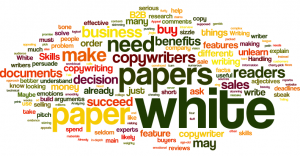
4 lessons copywriters must unlearn to write white papers
Copywriters can definitely write effective white papers.
You just need to unlearn a few things first.
As a copywriter, you already have many skills you can apply to writing white papers. You likely know how to:
- Do research
- Interview experts
- Write smoothly
- Meet short deadlines
- Handle reviews and comments
To succeed at writing white papers, you just need to unlearn a few lessons of the copywriting trade.
Skills copywriters already have
This table shows the skills you likely already have as a copywriter, and some you may need to build up to succeed as a white paper writer.
| Skills you already have | Skills you need to build |
|---|---|
| Analyzing an audience | Telling an engaging story |
| Doing in-depth research | Handling quotes and sources |
| Understanding B2B buyers | Proving your claims with evidence |
| Interviewing experts | Formatting documents for quick scanning |
| Writing to persuade | Writing to explain |
Four lesson copywriters must unlearn
Most copywriters have a few things drummed into their heads at college, on the job, and in bull sessions with colleagues.
Here are the four main habits you may need to rethink to succeed in white papers.
#1: Appeal to logic, not emotions
The best copywriting calls to the consumer’s emotions, painting a detailed vision of all the wonderful benefits they will enjoy after they buy.
Great copy holds out the promise of things like an exciting new career, radiant health, untold wealth, and a lifetime of adventure.
White papers are different.
They’re not aimed at consumers buying courses, vitamins, or travel packages. They’re for executives making a serious business decision worth a lot of money.
In a white paper, you write mainly to explain. When you do persuade, you use facts and logical arguments.
White papers are in the same league as press releases and annual reports. These business documents are expected to deliver facts and arguments, not fluff and pipe dreams.
So copywriters need to tone down the adjectives, superlatives, promises, and emotional appeals.
I’m not saying business buyers are robots with no feelings. But very few business people can afford to spend millions of dollars on impulse, because they saw a fun video on YouTube.
They buy because they’re convinced that a B2B vendor can help their company make money, save money, beat the competition, or serve their customers better. Nothing else really matters.
#2: Sell the steak, not the sizzle
A copywriter must give his work pizzazz. Any successful ad, brochure, jingle, or sales letter needs to be snappy to make an impression.
But white papers are different.
They’re serious business documents that should be dignified and helpful, not packed with zest and zing.
To write an effective white paper, tone down the hype, delete the fluffy adjectives, and abandon the gambit of “selling the sizzle.”
Instead, stick to the main course: the steak.
#3: Talk features, not benefits
When writing copy, you’re supposed to link every feature to the benefits it delivers. You seldom need to describe how anything works, just how much better people’s lives will be after they buy it.
You can sketch in a few highlights, or cherry-pick the most appealing features to mention as you build to your stirring conclusion: Buy now!
But white papers are different.
In a white paper, you may need to spend most of your text describing how some feature is implemented.
Maybe the product uses a completely new approach to solve an age-old problem. Maybe its materials are more durable or its algorithms more precise.
Many readers download a white paper specifically to discover the technical details about a company’s offerings. They want to understand the nitty-gritty about each key feature.
So skimming over the features and focusing on the benefits is probably not enough.
#4: Don’t ask for the order
Copywriting is often defined as “salesmanship in print.” This definition is dangerous for a white paper writer.
You never “ask for the order” in a white paper.
These documents are used for complex B2B sales, where numerous people come together to make a weighty decision. This decision can take weeks or months to complete.
Your goal in a white paper is to provide useful content that positions your company as a trusted advisor and engages prospects for the long haul.
At the end of the document, you encourage readers to take the next step along the path to a purchase, something like visiting a website to use an online ROI calculator.
You seldom ask readers to pick up the phone and place an order.
In fact, the #1 mistake too many writers make in too many white papers is too much selling.
Survey after survey reveals that white paper readers aren’t looking for a sales pitch.
They’re looking for useful information to help them understand an issue, solve a problem, or make a decision.
If you make your white paper a thinly veiled sales pitch, you will confound your readers’ expectations. You may even turn them off permanently.
By pushing too hard for the sale, you can lose any chance of making the sale.
Have you written both sales copy and white papers? What differences did you find? Please leave your comments below.
This post is excerpted from my book White Papers For Dummies. See what people are saying about it here.
The word cloud on this page was created with wordle.net from the text of this post.
Want to hear whenever there’s a fresh article on this site? Subscribe here to stay in the know on long-form content. From time to time, we’ll also send you word about some great new resource or training. And you can unsubscribe any time.




I think the belief that emotion plays no role in executive decision making is a false notion. I have a client that sells $30 million corporate jets, and you better believe the sale is made with emotion and justified by logic.
In the white paper itself Bob?
We talked about the heritage of the jet and the status and convenience. Admittedly the white paper was more about technical features. But we did not ignore the emotional appeal. Thinking that B2B decision are all logical is a common myth.
Fair enough, Bob, if you’re talking about “the sale” in total. But I’m talking about most of the content in most of the white papers used in most complex B2B sales.
I could argue that a corporate jet is almost an “impulse” buy for members of the 1%. Of course, ego and prestige play a role in deciding on something like that.
But not so much in buying software to help run a company, which is a more typical B2B complex sale.
My son is a software engineer and they are fiercely passionate about their preferences in programming languages, tools, technologies, and projects. Software and IT decisions have a huge emotional component. They are not the sterile, fact-based analysis you seem to think.
Compelling B2B content appeals to both human factors (emotions etc.) and business rationale. In case of whitepapers the technical prowess of the solution counts as well.
When Gordon says “non-salesy”, not too much superlatives, avoid hard selling etc… I don’t read those as saying “be totally numb to emotions”. In fact business decision makers are mostly very passionate (I know it first hand) & deeply engaged in their niche. However WP etc. is about building trust, credibility, strategic business relations Vs motivating “Order Now”, “buy risk free” (mind you that’s different from B2B free trials) etc. If a B2B purchase calls for a refund situation, then that “cost” is way more expensive than returning “those few bucks” to a consumer.
Gordon, your recent posts are turning out to be quite engaging 🙂